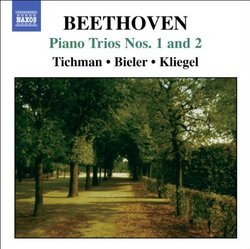| All Artists: Ludwig van Beethoven, Xyrion Trio Title: Beethoven: Piano Trios Nos. 1 & 2 Members Wishing: 0 Total Copies: 0 Label: Naxos Original Release Date: 1/1/2007 Re-Release Date: 4/24/2007 Genre: Classical Styles: Chamber Music, Historical Periods, Classical (c.1770-1830) Number of Discs: 1 SwapaCD Credits: 1 UPC: 747313272426 |
Search - Ludwig van Beethoven, Xyrion Trio :: Beethoven: Piano Trios Nos. 1 & 2
CD Details |
CD ReviewsEarly Beethoven Piano Trios Played with Spirit and Grace J Scott Morrison | Middlebury VT, USA | 06/08/2007 (4 out of 5 stars) "Unlike Beethoven's middle-period piano trios, the trios from Op. 1, two of the three of them presented here, are very early Beethoven and sound almost more like Haydn or one of his imitators than Beethoven. Not that that's a bad thing. It's just that they don't sound much like the Beethoven with whom we are most familiar. I reviewed an earlier volume in this series in which the Trios Nos. 5 & 6 were played by the Xyrion Trio -- it bugs me that I don't know the origin of the group's odd name -- and gave it a rave. Individually the players -- Nina Tichman, piano; Ida Bieler, violin; Maria Kliegel, cello -- have had sterling solo careers and since its formation in 2001 the Trio has forged an enviable reputation for exuberant, musical, technically secure performances and recordings. There is no exception to that in the present recording. The only relatively minor let-down, dare I say it, is with the music itself. Let's face it, the Beethoven of 1795 was still something of an apprentice, or at least he had not forged his recognizable style. For instance, the Op. 1, No. 1 Trio sounds like it could have come from someone like Stamitz or Eybler; indeed it starts with one of those clichéd 'Mannheim rockets' for which Stamitz was famous. Still, if one weren't expecting 'Beethoven' one could easily be pleased with these works on their own merits. So perhaps I'm being a bit harsh. It's a little like asking Verdi to have composed 'Falstaff' when he was twenty-five.
Those trivial caveats out of the way, the performances of these pieces are delightful. The First Trio, like the Second unusually in four rather than the common three movements, contains a sparkling finale with delightful skips in the piano part. The Second Trio opens with a Haydnesque slow introduction but when the main section arrives it is clear that Beethoven gives each of the three instruments more individual music to make than Haydn ever did in his numerous piano trios which were rightly considered to be piano sonatas with violin and cello accompaniment. The second movement, Largo con expressione, is a mostly serene set of variations; here the piano writing begins to sound more like the Beethoven of the early sonatas. The CD is filled out with the Allegretto in B Flat, WoO* 39, a five-minute piece written in 1812 for the young daughter of Antonie Brentano, the latter quite possibly Beethoven's 'immortal beloved.' It is a pleasant sonata-allegro in which the piano part dominates. *Werke ohne Opus (Works without Opus Number which, amusingly, are numbered anyway!) Scott Morrison " |

